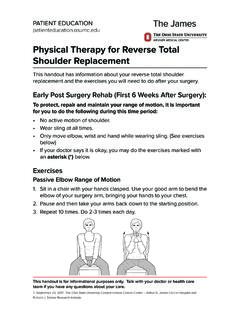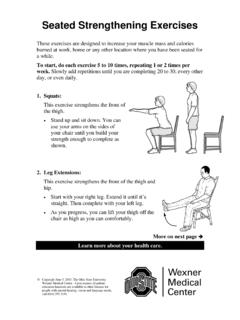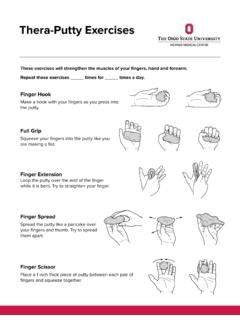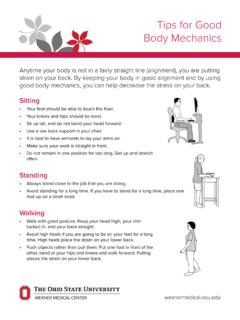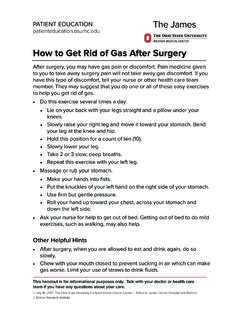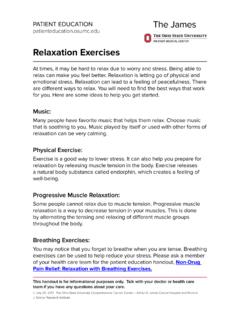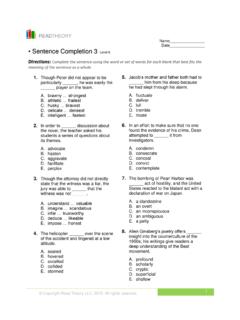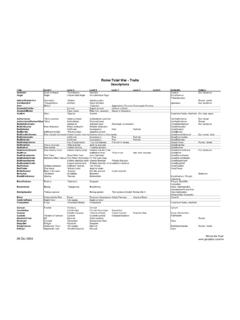Transcription of Biliary Drain - Pages - Patient Education
1 Biliary Drain What is a Biliary Drain ? A Biliary Drain is a tube to Drain bile from your liver. It is put in by a doctor called an Interventional Radiologist. The tube or catheter is placed through your skin and into your liver. You may also hear your Drain called a Biliary stent or Biliary catheter. The liver makes bile, which helps with the digestive process. The ducts carry the bile from the liver to the bowel. When the bile ducts are blocked, a Biliary Drain must be placed or the bile will back up causing a yellow skin color (jaundice), dark urine, light stools, nausea, poor appetite and sometimes itching.
2 The Biliary Drain will relieve these signs by draining the bile from the liver. A Biliary Drain may be placed because of leakage or a hole that forms in the bile duct. This leakage can cause severe pain or infection. Biliary drains also may be placed before surgery or for removal of a bile duct stone. Your doctors will discuss any risks of this procedure with you before it is done. More on next page . Learn more about your health care. Copyright 2006 - January 27, 2012. The Ohio State University Medical Center, Radiology - Upon request all Patient Education handouts are available in other formats for people with special hearing, vision and language needs, call (614) 293-3191.
3 Page 2. The catheter or Drain is about the size of an IV tube. It may be connected to a drainage bag or a cap is placed over the end of the Drain . The use of a drainage bag or cap is determined by your doctor. How long you will need your Drain depends on why it was placed. Your doctors will discuss with you how long you are likely to need your Drain . The two most common problems or risks of catheter placement are bleeding and infection, but these do not happen often. Your doctor will talk with you about these potential risks before the procedure. For placement of the catheter, tell your doctor if you are allergic to x-ray or contrast dyes, or iodine.
4 How do I prepare for a Biliary Drain ? There are things you need to do before your Drain is placed. Medicines Ask your doctor if you should make any changes to your medicines before this procedure. If you take a blood thinner medicine, such as Plavix, Coumadin or aspirin, you may need to stop the medicine before you have this procedure. Check with your doctor about when to stop the medicine. If you have a stent, be sure to talk with the doctor who placed the stent before stopping blood thinner medicines. If you have diabetes and take metformin (Glucophage, Glucophage XR) or glyburide/metformin (Glucovance), or any medicine with metformin in it: Do not take the medicine the morning of the procedure.
5 Do not take the medicine for the first 48 hours after the procedure. Restart the medicine on the third day after the procedure. If you take insulin for diabetes, check with your doctor about adjusting your insulin dose. If you have medicines to take the morning of the procedure, take them with small sips of water. Bring all your medicines to the hospital. Page 3. Eating Do not eat after midnight on the night before your procedure. You may have sips of water with your medicines. How will the Drain be placed? The Interventional Radiology team will talk to you before the procedure and answer any questions you may have.
6 Placing your Biliary Drain will take at least 2 hours. Blood will be taken for testing. An IV will be put in your arm and you will be given an antibiotic to reduce your risk of infection. You will also be given medicine to make you sleepy and to reduce pain. The skin and the deep tissues will be numbed with medicine so you will feel pressure during the procedure, but not pain. The doctor places a needle into the bile duct. Then a wire is put through the needle into the duct and the needle is removed. The catheter or Drain is placed over the wire and then the wire is removed, leaving the Drain in place.
7 The signs you were having before placement of the Biliary Drain will slowly go away. You may be sore for 7 to 10 days after the Drain is placed. What happens after the procedure? If you are an inpatient, you will go back to your hospital room where your nurse will be checking your vital signs and the Drain . You may feel sleepy, tired or dizzy for several hours after the procedure from the medicines. Your nurse will tell you when you can eat and get out of bed. If you are an outpatient, you will need someone to drive you home after your Drain is placed. You may feel sleepy, tired or dizzy for several hours from the medicine you were given.
8 Page 4. Your Care at Home Go home and rest for the remainder of the day. Do not drive or work around any mechanical equipment, power tools or appliance or sharp objects for 24 hours after your Drain was put in place. Avoid making any major life or legal decisions for at least 24 hours because you may not be able to think clearly or remember your actions. Eat light foods, like jello, pudding, soups, juices and other liquids for the rest of first day. Start back on your usual diet as tolerated the next day. Take your usual medicines when you get back home. If you take metformin (Glucophage, Glucophage XR) or glyburide/metformin (Glucovance) for diabetes, do not take that medicine for 48 hours after the catheter placement.
9 This is because it could react badly with the dye used to during the catheter placement. The dye clears from your body in a day or two. Drinking water helps to rid the dye from your body. Restart this medicine on the third day after the procedure. Your IV site may be tender for a day or two. If it gets red, hard, swollen, or more tender, use warm moist compresses on it for 20 minutes every hour. If the site gets redder, swollen or tender after 2 or 3 days, call your doctor. Some bruising or tenderness at the site of the Drain is common. It may be very mild bruising to black and blue, and it may be very small to about the size of a golf ball.
10 The site may also feel sore or tender. These signs may last for 2 weeks or longer. Warm moist compresses applied to the site for 20 minutes 2 or 3 times a day may help. Be sure to cover your dressing with plastic wrap first to keep it dry. Check your temperature each day while you have the Drain in place. Write your temperature down so you have a record. Page 5. When to Call the Doctor Outpatients: Call (614) 293-2773 or go to the nearest Emergency Room if you have: Active bleeding at the Drain site that does not stop after you put finger pressure on it More pain or swelling at or around the Drain site Your temperature is greater than 101 degrees Fahrenheit, with or without chills Skin care and showering Keep the Drain site dry.
